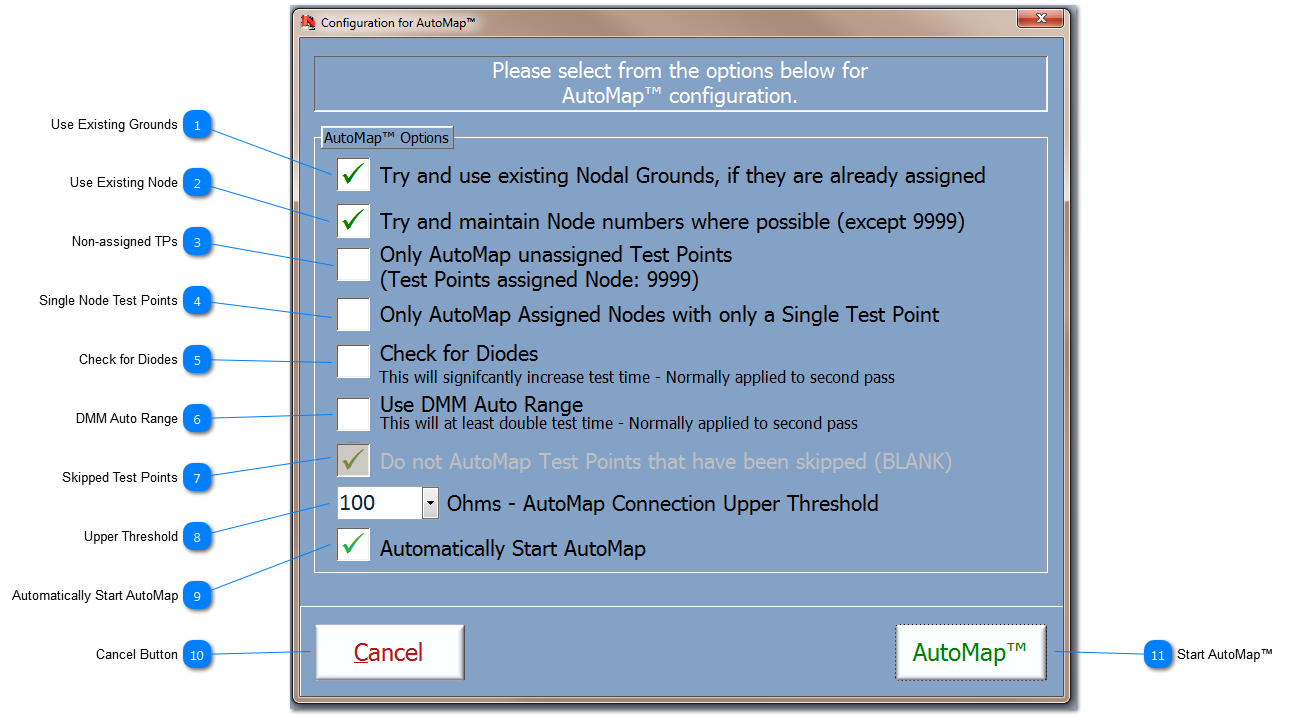 Use Existing Grounds If a theoretical schematic has been entered/imported into NODES™, or the results of a previous AutoMap has already been committed, then it might be that the UUT's current configuration could be fairly well established. Therefore, it might be impractical or ineffective, for AutoMap, to start allocating Nodal Grounds to the TPs on a first to test basis.
Therefore, by selecting this options, the User can request that any TPs that might have already been assigned as a Nodal Ground are tried as Nodal Ground points on a first pass; this does not mean a TP will be assigned as Nodal Ground if it is found that the circuit schematic, as discovered by the AutoMap utility, does not support such a configuration.
|
 Use Existing Node If a theoretical schematic has been entered/imported into NODES™, or the results of a previous AutoMap has already been committed, then it might be that the UUT's current configuration could be fairly well established. Therefore, it might be impractical or ineffective, for AutoMap, to start allocating Nodal numbers in a sequential order starting from 1.
Therefore, by selecting this options, the User can request that any TPs that might have already been assigned as a Nodal number (with the exception of 9999), that where its is possible and it aligns with the findings of the AutoMap utility, then the assign number will be retained.
|
 Non-assigned TPs The User can select this to speed up subsequent AutoMap runs. By selecting this option, the AutoMap utility will only try and assign those TPs that have been marked as 9999 in Node field. TPs looking to be assigned, will be tested against all TPs, including those already assigned, to ascertain if the TP under test is part of a substantiated node, or if a new node needs to be created.
|
 Single Node Test Points There may be instances where there are single TP nodes. This might have been deliberate when adding or importing TPs for a UUT, or it might be that during AutoMap runs, certain TPs might not seem like they are connected to any other TP; this may be because of the settings of the DMM and/or the value set for the Upper Threshold. Therefore, on subsequent AutoMap runs, it might be that to speed up the testing process, that only those orphaned TPs are tested against the other TPs using a new DMM or Upper Threshold setting/s.
|
 Check for Diodes During a normal AutoMap run, a TP will be checked against another TP in one direction only. Therefore, if the connection between the two TPs is a diode, it might be that it either passes or fails depending on the orientation of the diode and the testing path. The User can opt to check for Diodes in the UUT by selecting this option. During the AutoMap run, the two TPs under test, will be checked in both directions for a possible diode and saved as a list. After the main part of the AutoMap run, the List is then checked using the DMM Diode settings to further explore the possibility of a diode.
Note that using this option will increase the test time significant, and it could more than double a normal run time. It is suggested that this option is used for subsequent runs to the main AutoMap run, and in conjunction with one or more of the other options in order to narrow the test permutations.
|
 DMM Auto Range If the User is unsure of what continuity values might exist in a UUT, then it might be that the DMM is placed into Auto Range and the Upper Threshold increased.
Note that using this option will increase the test time significant, and it could more than double a normal run time. It is suggested that this option is used for subsequent runs to the main AutoMap run, and in conjunction with one or more of the other options in order to narrow the test permutations.
|
 Skipped Test Points An currently enforced option, which ensures that no TPs that have been skipped (assigned as BLANK) are included in the AutoMap process.
|
 Upper Threshold Set the Upper Threshold for a valid connection between two TPs under test. It is suggested that the Upper Threshold is set to 100Ohms for a main run of AutoMap; then for subsequent runs, the Upper Threshold is increased. This option should be used in conjunction with one or more of the other options in order to narrow the test permutations.
|
 Automatically Start AutoMap Select to start the AutoMap process as soon as the application has opened and initialised.
This option might be unchecked, to allow the User to review the current map configuration before the AutoMap process has been started.
|
 Cancel Button Click to close the Configuration of AutoMap and cancel the AutoMap process.
|
 Start AutoMap™ Click to start the AutoMap process.
|
Made with help of Dr.Explain
|
